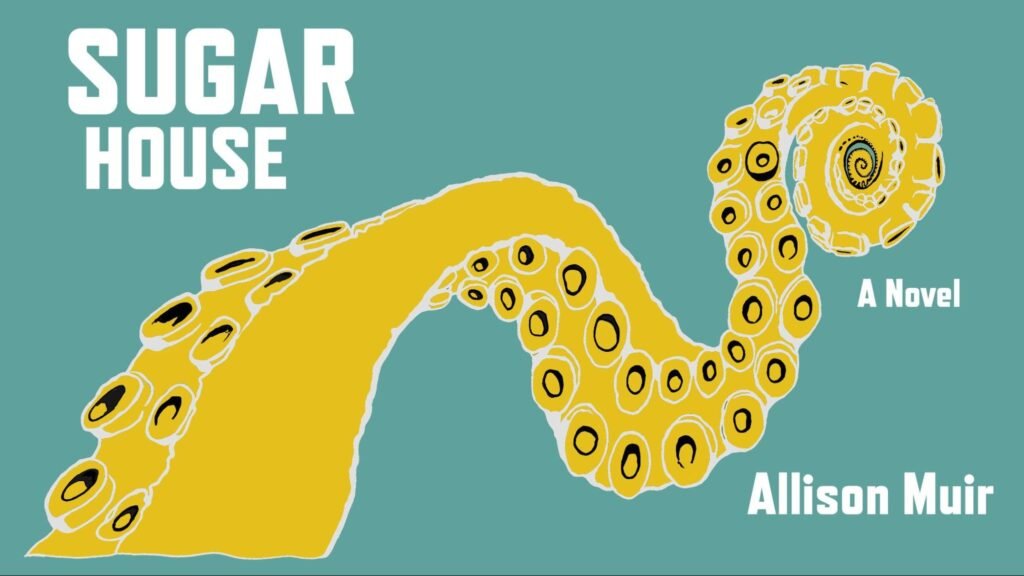
In an era of quick content and overnight releases, novelist Allison Muir took a different route, one paved with patience, parenthood, personal transformation, and an ever-deepening relationship to place. Her debut novel, Sugar House, is a literary mosaic sixteen years in the making: a magical, satirical, and emotionally resonant epic that reimagines California through a distinctly fabulist lens.
Described by Muir as “Roald Dahl meets a woman’s Wes Anderson,” Sugar House is at once quirky and precise, cinematic and literary, wild in imagination yet grounded in lived experience. The novel blends hyperbolic characters, personified animals, stylized satire, and deeply tender emotional arcs, all while dancing across a fantastical version of Northern California that feels both mythic and intimate.
A Novel Written in the Margins of Life
“I wasn’t larking about in a cabin like Henry Thoreau,” Muir says with a laugh. “I was raising children, remodeling homes, going back to school, starting a business. And all the while, Sugar House lived with me.”
From the moment she began writing the book, while pregnant with her first child, Muir knew she was embarking on something epic. Life added chapters of its own, but so did California. “The story kept unfurling every time I read the Chronicle, took a road trip, or wandered a museum,” she says.
What emerged is a generational novel that carries the DNA of its author’s lineage, families who helped build the Bay Area’s bridges, discovered gold, or rode for the Pony Express and a style enriched by her film school background, literary fandom, and punk-rock adolescence.
The Satirical and the Surreal
Sugar House’s tone is best described as fabulism with a razor-sharp edge. “There’s a dry, dark humor throughout,” Muir explains. “But I didn’t want the satire to erase the sincerity. Like Dahl, I wasn’t afraid of tenderness.”
Her ensemble cast reads like a Wes Anderson film script with added estrogen. While the aesthetic parallels are undeniable, quirky families, nested narratives, eccentric detail, Muir claims her story has a female center of gravity. “We’re dealing with motherhood, postpartum depression, and patriarchy. It’s stylized, yes, but deeply personal,” she says.
The structure of the novel borrows from film editing, short vignettes instead of traditional chapters, screenplay excerpts, and visual scene cuts that keep pace with its many characters and shifting timelines. Themes of voyeurism, surveillance, and spectacle echo throughout, calling on the reader not just to watch, but to question what they see.
California as Fable and Folklore
California looms large in Sugar House, but not the sun-soaked cliché of palm trees and promise. Instead, Muir conjures a state built on paradoxes: freedom and destruction, progress and erasure. “You can’t write this region straight,” she says. “It’s too weird to be true. We’re talking about the Zodiac Killer, Patty Hearst, the Black Panthers, and the Grateful Dead all converging in a single cultural moment.”
Muir’s family roots and local knowledge deepen the authenticity. “I was raised in the Bay Area punk scene, with a mom from a Mormon commune and a dad in early Silicon Valley,” she says. “That complexity, and contradiction, is what I try to capture.”
Writing Outside the Lines
Perhaps the greatest risk Muir took wasn’t just her unapologetically sprawling cast or refusal to conform to genre expectations, it was staying with this project for nearly two decades. In a publishing world obsessed with market fit, she faced an uphill battle. “We debated five BISG codes,” she says. “Magical Realism, Satire, Dark Humor, Alternative History… We finally landed on Satire and Alternative History, but even that felt reductive.”
Fortunately, indie publisher High Frequency Press gave Muir the freedom she needed to let the book become what it wanted to be: strange, smart, genre-defiant and utterly itself.
The Long Road Home
Surprisingly, most of Sugar House was written by hand. Muir credits her creative process to what she jokingly calls “Yoga for Writers,” a movement practice taught by columnist-turned-yogi Mark Morford. “It helped me tap into the mind-body connection and overcome blocks,” she shares. “There’s something ancient and grounding about writing longhand.”
Now that Sugar House is out in the world, Muir feels a bittersweet pride, like a parent watching their child board a city bus alone for the first time. “We’ve lived together, cried together, even slept in the same bed,” she says. “I raised this book alongside my children. It holds sixteen years of my life.”
And it shows. Every page of Sugar House carries the weight and wonder of a story carefully aged, courageously written, and finally, joyfully released.
